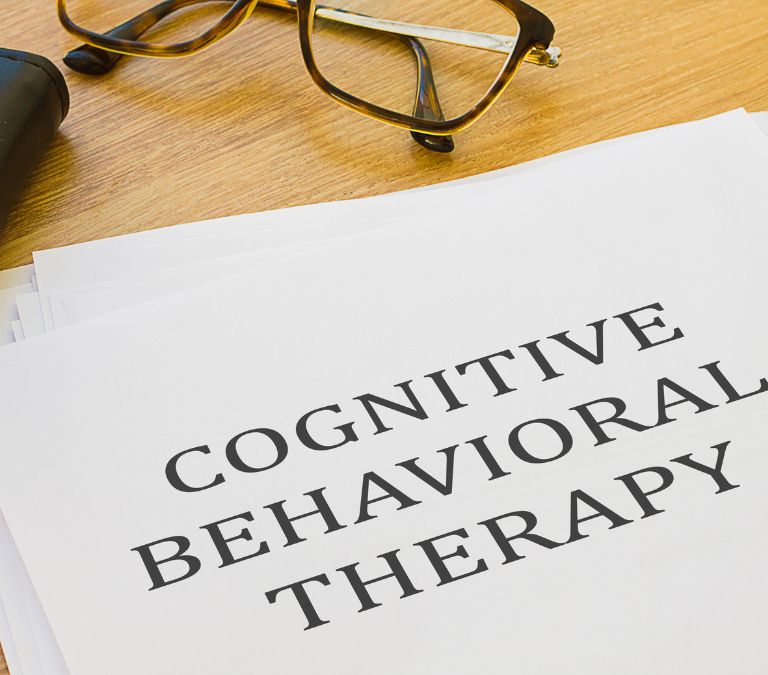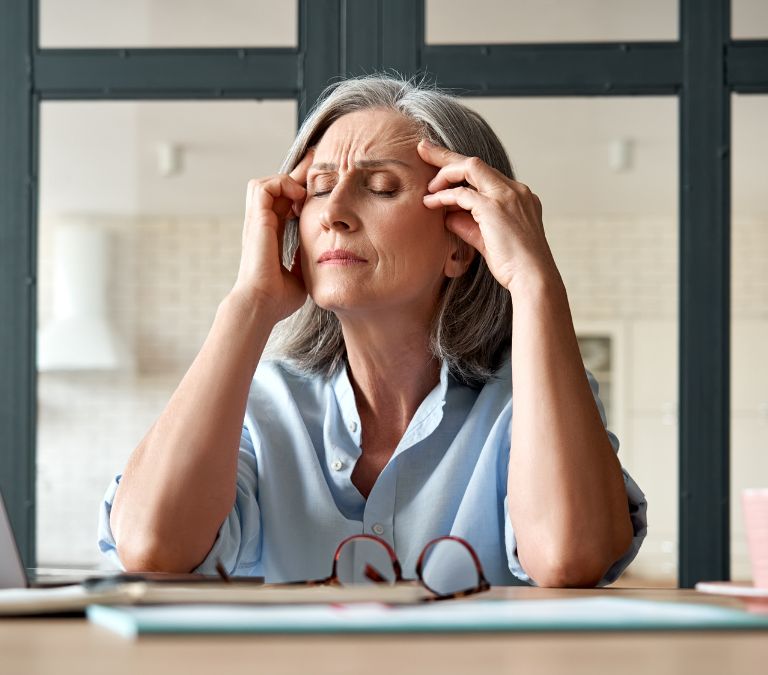Do you experience mood swings, hot flashes, or restless nights during menopause? These are common symptoms of anxiety experienced by most midlife women. According to studies, up to 51% of women between the ages of 40 and 55 experience anxiety symptoms.
Even though it is a common natural phase in every woman’s life, dealing with it comes with challenges. But knowledge is a powerful thing. You may take control of your mental health by being more aware of why menopause causes anxiety, the exercises and treatment options to calm it down, and the effects of social media on midlife women suffering from anxiety. This post will discuss these topics to set you on the right path.
Does Menopause Cause Anxiety?

Every woman’s experience with menopause is different and, for many women, unpredictable, and we all get anxious in uncertain situations. However, several studies have established a connection between menopause and anxiety.
It might be challenging to comprehend why you could be experiencing various emotions throughout menopause, but it’s vital to stop and think about all the hormonal and chemical changes in the brain that are taking place at this time. Your hormone levels are declining, which results in decreased amounts of several brain chemicals, including serotonin. Lack of serotonin in your system can cause anxiety, panic attacks, despair, and erratic moods.
Anxiety symptoms might develop with the start of menopause and its accompanying physiological, psychological, and cognitive changes. In reality, hot flashes and anxiety are closely related. Additionally, tension and anxiety are naturally triggered by symptoms like sleep loss and diminished mental clarity.
Menopause timing is another factor that occurs simultaneously with other significant midlife changes. It is typically the end of a woman’s reproductive years, and as children become older, parenting and health problems might arise. You may also be worried about your body image as you age. At the same time, reassessing decisions about one’s job, life objectives, and relationships is common throughout midlife. Stress and anxiety symptoms might result from any of these factors.
Women frequently anticipate menopausal mood changes, but being aware of the signs of anxiety might help you find the relief you need.
Other commonly reported signs and symptoms of anxiety during menopause include:
- Chills
- Nausea
- Shaking
- Irritability
- Dizziness
- Panic attacks
- Heart palpitations
- Shortness of breath
- Reduced ability to concentrate and focus
- Sweating/hot flashes (also called vasomotor symptoms or VMS)
8 Deep Breathing Exercises for Anxiety

Anxiety can have a toll on your emotions, health, and your life in general. And while managing your symptoms frequently necessitates a combination of short- and long-term approaches, one simple technique can make you feel calmer as soon as anxiety creeps in.
It is known as deep breathing. Although it may seem quite simple, it is widely regarded as one of the most effective stress-lowering methods.
Deep breathing sets off a series of physiological processes that tell your brain that everything is, in fact, fine: it aids in the proper exchange of oxygen and carbon dioxide, lowers blood pressure, and slows the heartbeat, all of which encourage a state of relaxation and calmness.
Although you may take breathing lightly, there are many exercises you may perform when you feel things are about to go out of hand.
- Nadi shodhana or alternate-nostril breathing
This deep breathing exercise involves closing one nostril and breathing through the other while alternating between nostrils in a regular sequence.
It’s essential to practice this kind of anxiety-relieving breathing while seated.
- Raise your right hand while keeping your left hand on your lap. Next, place your right hand’s index and middle fingers on your head, in the space between your brows. As you breathe in and out through your nose, close your eyes.
- Close the right nostril with your right thumb and take a deep breath through your left.
- Pinch your nose shut using your right ring finger and thumb to hold your breath briefly.
- Block your left nostril using your right ring finger and exhale through the right nostril, pausing before you inhale again
- Breathe in slowly through your right nostril.
- Again, pinch your nose shut, holding your breath for a moment.
- Open your left side now and take a deep breath in before exhaling.
Try to complete 10 rounds of these breathing exercises. The maximum time for a cycle is 40 seconds. If you start to feel dizzy, release both nostrils and breath normally for a moment.
- Abdomen Breathing
Abdomen breathing involves breathing from your diaphragm. This exercise helps in reducing the amount of effort your body requires for breathing.
Here are simple ways you can learn how to breathe from your diaphragm.
- Lay down on the floor or a bed and place cushions under your knees and your head for comfort. Alternatively, sit comfortably in a chair with your legs bent and your neck, head, and shoulders at ease.
- Next, place one hand over your heart and the other beneath your ribs.
- As you breathe in and out through your nose, pay attention to any chest and abdominal movements. Ensure your stomach is moving instead of your chest.
You may feel tired if it’s your first time trying diaphragmatic breathing. But it’ll become easier as you practice it daily.
- 4-7-8 Breathing
The relaxing breath, commonly known as the 4-7-8 breathing exercise, calms the nervous system. The exercise is best done initially while sitting and with your back straight. However, you may do this breathing exercise while resting in bed after you get more accustomed to it.
- For the length of the workout, press the tip of your tongue on the tissue ridge behind your top front teeth.
- Make a “whoosh” sound as you exhale through your mouth.
- Then, gently inhale through your nose while counting to four in your head.
- Hold your breath and count up to seven.
- Make a whooshing sound while exhaling your mouth, counting to eight.
- Equal Breathing
Equal breathing is a different type that evolved from the traditional pranayama yoga. It involves breathing in for the same duration as you breathe out.
Either sitting or laying down are suitable positions for practicing equal breathing. Regardless of the position you select, make sure to settle in.
Close your eyes and take a few breaths, focusing on how you typically breathe.
Then slowly inhale through your nostrils while counting 1-2-3-4.
Exhale for the exact four seconds.
Pay attention to how your lungs feel full and empty as you inhale and exhale.
Your second count could change as you continue to practice equal breathing. Just ensure you the length of your inhale and exhale are equal.
- Lion’s Breath
As the name suggests, the yoga breathing technique includes exhaling like a lion’s roar. It can reduce tension, loosen up your facial and jaw muscles, and enhance cardiovascular health.
- Spread as wide as you can and breathe in through your nose.
- Stretch your tongue out in a long, downward motion toward your chin.
- Exhale forcefully while moving the breath across the tongue’s root.
- Make a deep “ha” sound from the center of your abdomen as you exhale.
- Breathe normally for a moment.
- You should repeat this exercise up to seven times.
- Four-square breathing
Four-square breathing, called box breathing, is relatively easy to learn and use. You’re already accustomed to timed breathing if you’ve ever caught yourself inhaling and exhaling to the beat of the music. It goes as follows:
- As you exhale, count to four.
- For a count of four, hold your breath.
- To the count of four, inhale.
- Hold the breath in your lungs for four counts.
- Exhale, then restart the rhythm.
- Mindful Breathing
Focusing on your breathing and keeping your attention in the present moment without letting your thoughts wander to the past or the future are key components of mindfulness meditation.
- Pick a relaxing focus, such as the sound “om,” a word that conveys serenity, or a phrase like “breathe in peace, breathe out stress,” and repeat it aloud as you breathe in or out.
- Think of your inhalation as a gentle wave that covers you.
- Imagine the energy and ideas that are distressing and negative, leaving you as you exhale.
- If you become distracted, gently return your focus to your breathing and words.
- Resonant breathing
Resonant breathing, also known as coherent breathing, can help you relax and reduce anxiety. To put it into practice:
- Close your eyes and lie down.
- Breathe slowly via your nose, with your mouth closed, for six seconds.
- Don’t overfill your lungs with air.
- Exhale softly and gently for six seconds. Please don’t push it.
- Continue for a total of 10 minutes.
- Spend a few more minutes being motionless and paying attention to how your body feels.
Treating Anxiety Attacks through Cognitive Behavioral Therapy ( CBT )

Anxiety has no fast remedy. While deep breathing exercises are often essential elements of a successful treatment program, therapy can help you deal with anxiety. It can assist you in determining the source of your anxiety and the measures you can take to counteract it. Cognitive behavioral therapy (CBT) is one of the treatment options that has been effective over the years.
CBT is a treatment that focuses on identifying and restructuring negative thinking patterns or behaviors. In other words, CBT can assist you in changing your approach to a circumstance.
For example, people’s feelings, thoughts, and behaviors can change when they start a new job. These variations are all influenced by our beliefs, personal attitudes, and assumptions about our situations.
When you experience anxiety, your negative thoughts and emotions overpower your pleasant ones. Fear and feelings of unworthiness might take control. The purpose of CBT is to change the way you think. You may modify your feelings about a circumstance by doing so.
CBT Techniques for Anxiety
Some popular approaches used by CBT practitioners to help you deal with anxiety and modify your behavior.
- Cognitive Reframing or Restructuring
It entails scrutinizing negative mental processes. Perhaps you tend to:
- Overgeneralizing
- Always expecting the worst.
- Place an excessive emphasis on little things.
Thinking in this manner can influence your actions and, in certain cases, become a self-fulfilling prophecy.
Your therapist will inquire about your cognitive processes in various settings for you to uncover detrimental patterns. Once you’ve identified them, you may learn how to reframe them to be more positive and productive.
- Thought Challenging
‘Thought challenging’ involves evaluating things from many perspectives and utilizing real-life examples. Thought challenging may help you analyze things from a more unbiased perspective, rather than simply believing that your opinions are the facts or reality.
You may have difficulty rationalizing circumstances if you are anxious. You may be anxious and still be unsure of where it comes from. Or you might be afraid of something, like social events, but you’re not sure why.
- Activation of Behavior
If worry keeps you from doing anything, you may plan it by writing it down on your calendar. It creates a plan, so you don’t have to worry about it.
For example, if you are concerned about your children being ill at a playground, you can plan a park visit with a friend. It will motivate you to continue forward and confront the challenge, armed with the strategies you practiced in CBT.
- Journaling
Journaling, also known as thought recording, allows you to connect with and become aware of your feelings and thoughts. It can also aid in the clarification and organization of your ideas.
Note your negative ideas and the good ones you can replace them with. Your therapist may advise you to keep a journal of the new behaviors, skills, and practices between therapy sessions.
- Behavioral Experiments
These are typically utilized when you have destructive thinking and when you always assume the worst will happen.
You and your therapist might talk about what you expected would happen and whether or not it happened. With time, you’ll realize that your worst-case situation is unlikely to occur.
Effects of Social Media on Someone Suffering From Anxiety Attack

Social media is an important component of our everyday lives. You’re not alone if you wake up every morning and go for your phone to check Facebook. I do that, too. According to Statista, approximately 82% of Americans presently utilize at least one social networking platform.
Many things can influence how you respond to social media. Using social media may affect your symptoms if you are dealing with anxiety. In general, certain aspects of social networking may be beneficial to you. However, the negative effects are more predominant than the benefits. Here are some of the negative effects you need to be aware of.
- Inadequacy in One’s Life or Appearance
Though menopause has to do with the reproductive system, it is also a time we experience changes in our looks. So, even if you know that the pictures you see on social media sites have been edited, they might make you feel anxious about your body image or what is happening in your life.
Similarly, we are all aware that others like to discuss just the juicy aspects of their life. But that doesn’t stop you from feeling envious and resentful when you go through a friend’s well-edited pictures of their romantic beach vacation or read about their amazing new job advancement.
- Fear of Missing Out (FOMO)
While FOMO existed long before social media, sites like Instagram and Facebook appear to amplify thoughts that others are having more fun or enjoying better lives than you. It can make you feel like you’re missing out on important things, which might lower your self-esteem, intensify anxiety, and drive you to use social media even more.
FOMO might drive you to grab your phone now and then to check for updates or respond impulsively to every alert—even if it means endangering your life while driving, depriving yourself of healthy sleep, or putting social media engagement over real-world connections.
Staying up all night to use social media may cause difficulty falling asleep, and a lack of sleep may exacerbate feelings of anxiety or even depression.
- Heightened Feeling of Loneliness
A University of Pennsylvania study discovered that frequent use of Snapchat, Facebook, and Instagram enhances rather than lowers feelings of isolation. In contrast, the researchers discovered that reducing your use of social media sites might help you feel less isolated and lonely and increase your overall wellness.
The feelings of loneliness created by social media sites may cause stress, especially if you feel compelled to stay connected to the digital world.
- Lack of Human Touch
Humans require in-person interaction to be mentally healthy. Nothing decreases stress and enhances your mood more quickly or adequately than making eye contact with a loved one or friend. The more you place importance on social media contact over real-life connections, the higher the chances of developing or worsening mood disorders like anxiety and depression.
- Self-absorption
Sharing countless photos and deepest thoughts on sites like Instagram can lead to detrimental self-centeredness and distract you from real-life interactions.
The Benefits of Social Media
While virtual connection on social media does not provide the same psychological advantages as face-to-face contact, it can nevertheless help you stay connected and improve your mental health in various ways.
- Social media sites can make it easier for those who suffer from social anxiety to begin and maintain social contact.
- When transportation, solitude, or dread of leaving the house is a problem, these sites can make it simpler for some people dealing with anxiety to become active in connecting with others.
- You may feel less anxious while engaging online than in-person, allowing you to practice social skills in a more secure setting.
Tips for Efficient Usage of Social Media
- Take note of the tone with which you share or comment. Negativity or complaints are less likely to inspire others to connect with you than being cheerful and open.
- Balance the time you spend on social media. Alternatively, leverage the time you spend online to organize activities in the actual world.
- Practice mindfulness to become more aware of your surroundings and avoid letting social media consume your whole day.
- Consider signing up for meetup groups or find a group of individuals who share your interests or hobbies. It is especially useful if you have a small circle of friends in real life and wish to expand your network through social networking.
- Keep in mind that not everything you find online is completely truthful. What you see on social media sites is not always an accurate depiction of the lives of many people you know. Some individuals only share the good, while others only share the bad—try not to compare or consider what others have that you don’t.
- Avoid being a passive social networking site user. Don’t waste time scrolling through other people’s postings without saying something about yourself.
Conclusion
Anxiety symptoms associated with menopause range from mild to severe and might vary depending on physical causes such as night sweats, lack of sleep, and hot flashes. Keep in mind that you are not alone. Be proactive with self-care, especially if you are experiencing disruptive symptoms that are interfering with your everyday life. Take back control by educating yourself and consulting with mental health specialists.
It is also crucial to always remember that anxiety does not have a fast remedy. It takes time and dedication to overcome an anxiety problem. Because therapy entails confronting your concerns rather than ignoring them, you may feel worse before you feel better.
The main thing is to continue with therapy and listen to your therapist. If your recovery rate is discouraging, remember that anxiety therapy is quite helpful in the long term. If you stick with it, you’ll enjoy the advantages.
Making good decisions can also help your anxiety therapy. Anxiety is influenced by various factors, including your level of exercise and social life. Make a deliberate decision to foster relaxation, vigor, and a positive mental perspective in your daily life to set the stage for success.







